For years we have been talking about learning to write code through game play with things like Gamestar Mechanic and Double Fine’s Hack and Slash (which requires you to change the code of the game’s assets in order to win), but the recent attention that folks like YouTuber SethBling has gotten for writing code with his gameplay is even more interesting. In the following video Seth walks you through how he uses the game itself (and the placement of certain items in game in order to write to the RAM of the game) and trigger a game ending (or “winning”) glitch called the “Credits Warp” that causes you to warp directly to the end credits.
I find this kind of speedrun even more fascinating than the traditional speedrun that usually relies on a series of exploits to make it to the end of a game with record breaking speed. A great example of this is Cosmo’s Legend of Zelda: Wind Waker speedrun that uses a bomb glitch (aka zombie hover) to hover through a dungeon quickly and shave a ton of time off of the final speedrun time.
While the bomb glitch is useful and interesting when you consider the time spent on trial and error to figure out the more time efficient way to make it through an entire game in a fraction of the time that it would normally take, the “Credit Warp” that actually calls for the gamer to use item placement to actually write to the RAM of the console to trigger a glitch that takes him straight to the closing credits of the game and in essence “finishing” the game. It’s this specific kind of post production editing of the game through code that calls for very specific cognitive capabilities and adds a a layer of depth to the notion of the modding of games that we are more accustomed to seeing. Here, players, like Seth, are not editing the code on a line by line basis but rather using in game items placed at various points on a specific X/Y axis to, in essence, change the hardware and the way that it renders the game.
 I think that what draws me to these RAM glitches so intensely is the fact that they are visual in nature, but making changes to the actual code in a kind of roundabout way. And I am beginning to wonder what this will have to say for the future of coding and the future of gaming. Have we moved to a new level of meta-gaming/meta-programming (past even the stage of things like Project Spark)? Will this/Can this/Should this change the design of games and game engines in the future. Will we be looking back to the possibilities of old consoles to learn something new for the new ones? Why is there so much community interest in RAM coding glitches and so little, comparatively, in things like Project Spark? Is it that folks are more interested in going for the seemingly impossible than they are for going for the freely allowable? Is forbidden fruit really the sweetest?
I think that what draws me to these RAM glitches so intensely is the fact that they are visual in nature, but making changes to the actual code in a kind of roundabout way. And I am beginning to wonder what this will have to say for the future of coding and the future of gaming. Have we moved to a new level of meta-gaming/meta-programming (past even the stage of things like Project Spark)? Will this/Can this/Should this change the design of games and game engines in the future. Will we be looking back to the possibilities of old consoles to learn something new for the new ones? Why is there so much community interest in RAM coding glitches and so little, comparatively, in things like Project Spark? Is it that folks are more interested in going for the seemingly impossible than they are for going for the freely allowable? Is forbidden fruit really the sweetest?
*Edited to note that it is Legend of Zelda: Wind Waker with the zombie hover and also to note that Cosmo also does a very cool RAM exploit of his own in his Ocarina of Time speedrun.




